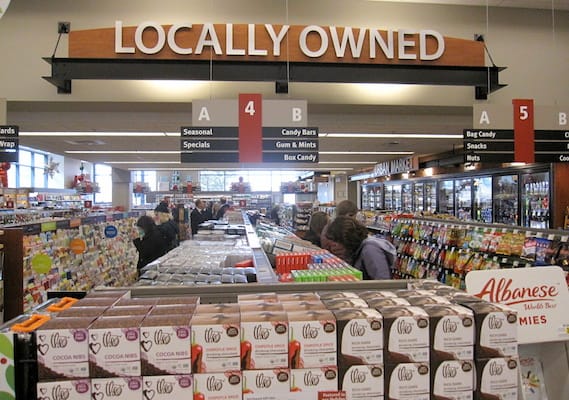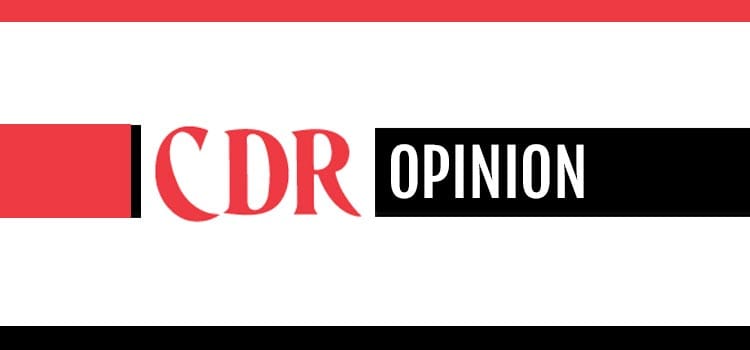For practical purposes, we all consider convenience stores to belong to one retail sector and drug stores to another. In a very real sense, however, the modern chain drug store is a c-store.
Convenience is the raison d’être for the extraordinarily well-positioned real estate of the drug store sector as a whole. The strategy, of course, is to create one-stop-shopping destinations for neighborhood customers who already need to visit the store to pick up prescriptions. In this model, the role of the pharmacy is roughly analogous to that of the gas pump at c-stores — it is the primary traffic driver.

Bartell Drugs enhanced its local flavor with displays of locally made products.
But in case you haven’t noticed, traditional c-stores are coming into their own with strategies that substantially augment this approach. The idea is not just to ramp up productivity by offering more reasons to walk into the store; it is to elevate the experience in order to cement brand loyalty and drive repeat visits.
When you walk into a chain drug store today, is there anything novel or exciting about the experience? How does the overall atmosphere make you feel? “Experiential” is the biggest buzzword by far in all sectors of retail today. Yet, the experience in our drug stores has remained remarkably cookie-cutter (with a few exceptions). Often, a customer simply walks into a wall of end-cap fixtures.
C-stores, by contrast, have shown a greater willingness to experiment with their formats. When Wawa moved into Florida, the Pennsylvania-based chain scored a big hit with its use of “fresh” decorating cues such as natural materials, floor-to-ceiling glass windows to provide inside-out retailing, warm colors, outdoor seating areas, and highly visible kitchen and sandwich-making areas. For many in the Sunshine State, this elevated offering, with its fresh-baked bread and signature coffee presentation, was truly novel.

Other examples of this approach (and there are many) include Argentina’s Axion Spot! Café, which is a c-store designed around an authentic café experience, or Eastern Europe’s MOL Fresh Corner stores, which offer fresh food and branded coffee. Back home, some West Coast c-stores even sell gourmet tacos from outdoor food carts. The point here is not just to give people something new to eat — it is to add theater.
National chain drug stores can, and should, raise their game as well. That means finding viable ways to enliven today’s cookie-cutter experiences. Of course, it would be impossible for a chain with 1,200 stores to offer a thoroughly unique experience at each location. However, bringing some degree of localization to individual stores — especially those in distinct locales with high traffic — is doable.
This is about more than swapping out seasonal merchandising. Bringing in sand toy and beach chair displays over the summer is not localization, and since everyone does it, this is hardly an effective tactic. Localization requires a willingness to decentralize and collaborate with store managers to stock select merchandise that speaks directly to the needs and priorities of local shoppers.
Knowing the neighborhood firsthand is a critical part of the localization process, because numbers alone can be misleading. Years ago, when Virgin Entertainment was planning a megastore for Union Square in Manhattan, the merchandise was originally programmed around classical music. Online research and stats for the neighborhood indicated a wealthier, older demographic. And yet half-a-dozen colleges and universities surrounded the Union Square store.
Why had the software failed to record these young people? They were not “permanent residents” and, thus, not included in demographic research. After realizing this oversight, Virgin reprogrammed the store around rock and world music.
New York City pharmacy chain Duane Reade is one player that has sought to bring local angles to its stores through a rebranding initiative. In Brooklyn’s Williamsburg neighborhood — where you’ll find no shortage of craft beer hot spots such as Threes Brewing, The Brooklyn Brewery, Beer Boutique and Mugs Ale House — it was a logical choice for Duane Reade to add a craft beer growler bar to its reinvented store. In Downtown Manhattan, though, Duane Reade’s research showed that customers were particularly in need of high-quality fast food, available on the go. Here a sushi bar made the most sense.
Walk into certain Seattle-area Bartell Drugs locations, and you’ll find end-of-aisle displays featuring what might seem to be an unusual item: Spam, the kitschy meat product by Hormel, most loved by Hawaiians. Given its relative proximity to Hawaii, Seattle has a relatively large population of native Hawaiian islanders. So Bartell moved to meet this demand in a way that highlighted its grasp of local culture.
Along the same lines, Bartell made sure to prominently display products by Seattle-based Theo’s Chocolate as a way to help localize its stores. These higher-end products were given an elevated and centered presentation, with more mainstream candies still accessible on the racks below.
In the old days, Bartell was a soda shop that was popular up and down the West Coast. To localize a South Lake Union store popular with Seattle urbanites, Bartell took advantage of the store’s classic long bar and bar stools by partnering with a local ice creamery and gelato store. Now customers can stroll in, order a root beer float or a sarsaparilla, and have the kind of experience that you just can’t find at every chain drug store.
Improvements in the customer experience need not always be rooted in local history and character. Duane Reade, for example, supplemented greeting cards from its core American Greetings brand with an attractive branded display by that company’s higher-end Papyrus unit, supplier of better-quality cards, gifts and stationery. Small touches such as this add up quickly. Suddenly, your store has more cachet.
The fundamentals of retail design also matter — especially given that the rest of retail is so obsessed with ramping up the customer experience.
At better American c-stores, the “stack it high” merchandizing model is gone, replaced with shorter gondolas that give the place a lighter, airier feel. In addition to making the coolers more visible, this helps female customers feel safer and more comfortable. And yet in the drug store business we still find 7-foot-tall gondolas that tower over shoppers and block critical sight lines. How can we ramp up beauty sales if female customers consciously or unconsciously feel unsafe to linger on the beauty aisle?
Finally, U.S. drug stores could find new sources of inspiration by studying how the customer experience is evolving in international markets. In Brazil, for example, one chain is already working with designers to better integrate into the flow of its stores the experience of visiting a medical technician for an immunization.
Today, as major drug chains continue to add walk-in clinics to their stores, they could do more to integrate this growing focus on consultative health, wellness and medical services into the customer journey. Specifically, there is potential here to create consultation spaces (served by relevant merchandise displays) that communicate on-brand messages to consumers.
A clinic need not feel overly clinical. Open designs with reassuring colors, wellness-oriented visuals and other flourishes can create a pleasing experience. This is especially important if a wait is likely to be part of the journey.
Of course, facilitating customer interaction with pharmacists and wellness ambassadors should be central to these efforts — and a number of U.S. chains have already made strides in this area.
At older stores, high counters between pharmacists and patients created an unwelcome barrier. Duane Reade, for one, embraced lower counters in order to restore a sense of personal connection.
With about 30,000 chain drug stores in the United States alone, the top chains already create retail experiences for millions of people. There is tremendous opportunity at every touch point to convey brand messages, cement customer loyalty and increase foot traffic and sales in location-appropriate merchandise. Duane Reade’s Growler Bar would never have worked if it was not the right strategy from the start. And yet all too often the experience of shopping at a drug store feels functional and flat.
If drug stores were islands unto themselves, they could afford to stay the same. Don’t allow your competitors to eat your lunch. It’s time to differentiate.
James Sundstad (james@cbx.com) is vice president of branded environments for CBX, a brand agency and retail design consultancy. Anthony Deen (adeen@cbx.com) is CBX’s creative director of branded environments.









